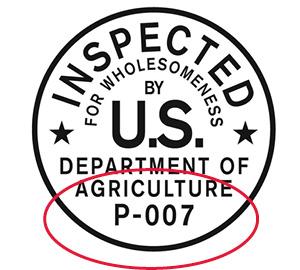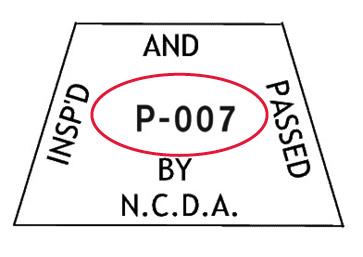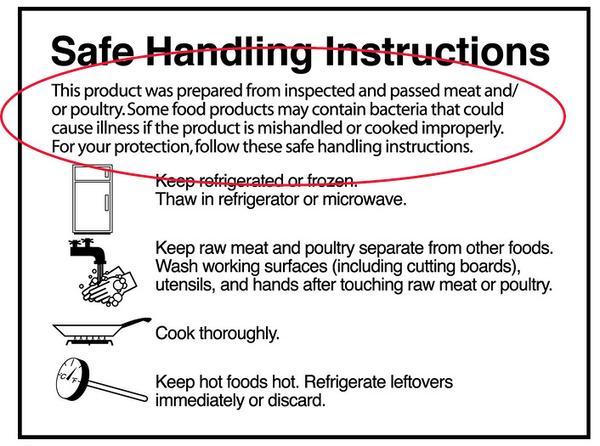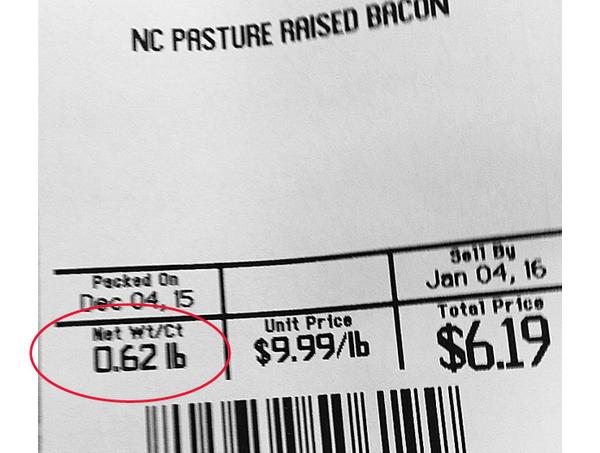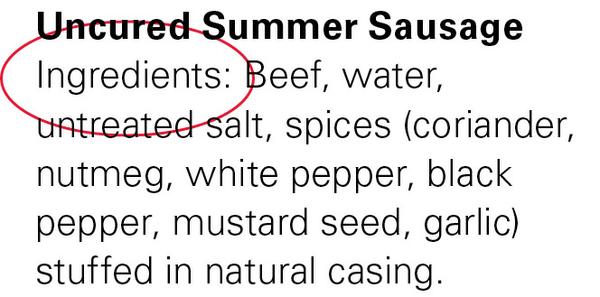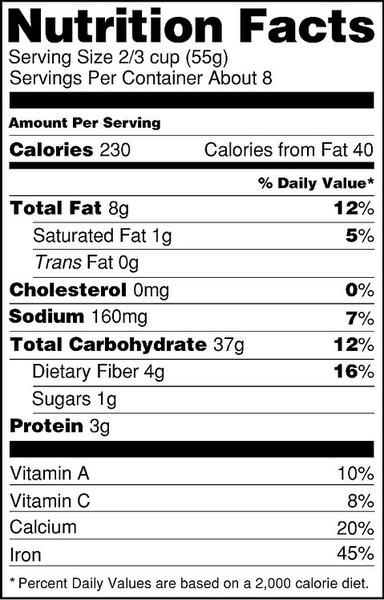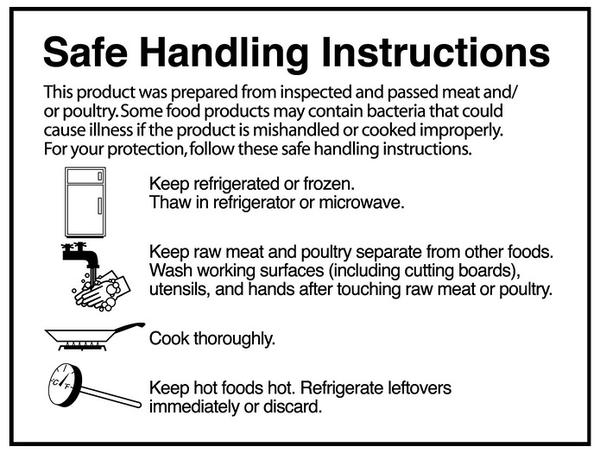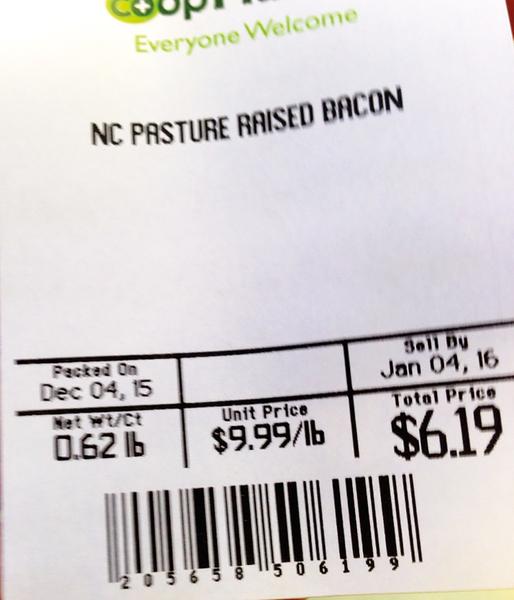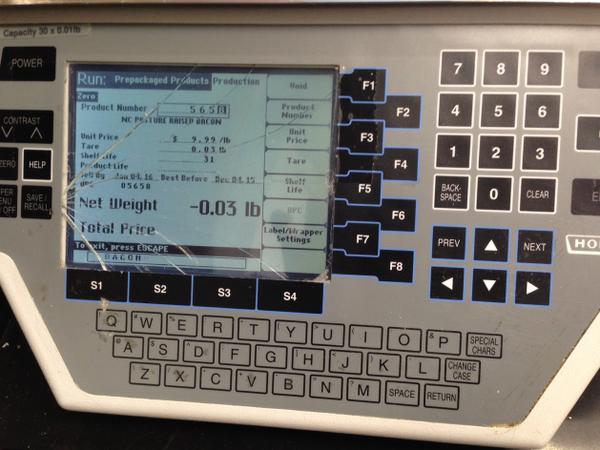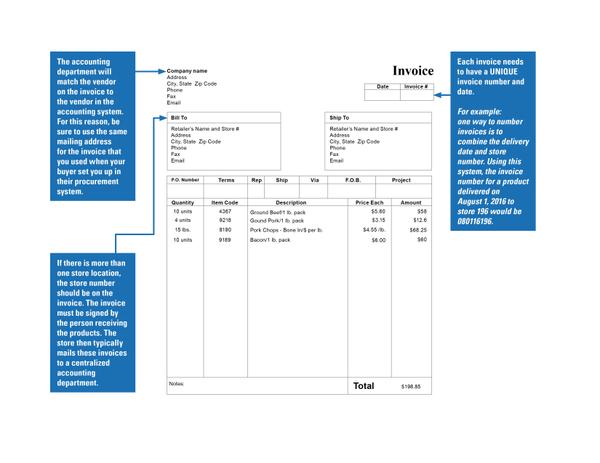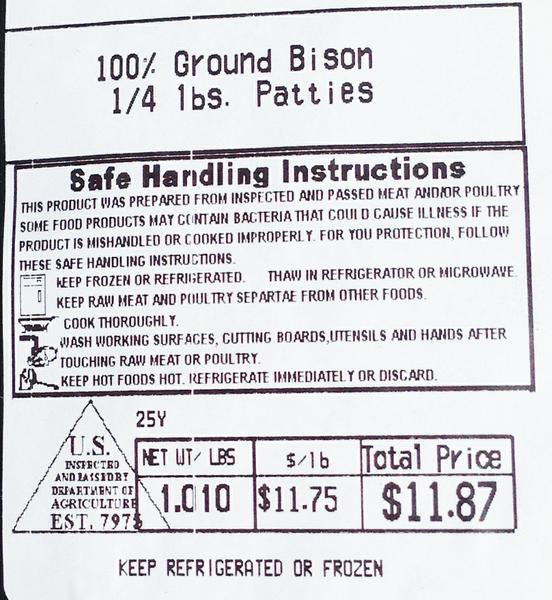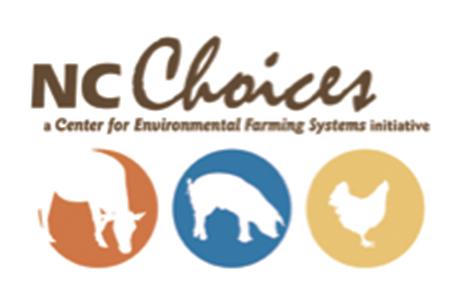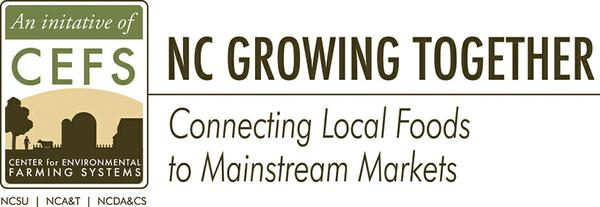Are you a small- or medium-scale pastured meat producer in North Carolina? Are you interested in expanding your markets into community grocery stores, co-ops, and other retail stores? This publication will help you get started on connecting to these stores through direct-store-delivery (DSD).
Consumers are increasingly looking for products that are produced close to home by farms they know or recognize. Retail outlets like grocery stores provide an opportunity to meet consumer demand for locally produced, pasture-raised meats while potentially providing you with an additional sales outlet.
The purpose of this publication is to provide guidance to niche meat producers who are interested in selling packaged fresh or frozen meat products through direct-store-delivery (DSD). This method of delivery gives producers the opportunity to sell smaller volumes of product directly to individual grocery or specialty stores, thus bypassing the wholesaler/distributor. Small- and mid-scale niche meat producers typically do not have the volume needed to satisfy the requirements of a wholesaler/distributor that services numerous stores. By delivering directly to stores, producers can access a market channel that would otherwise be closed to them, as well as establish relationships with retailers seeking to buy directly from local growers.
Note: The regulatory guidance provided in this document is based on the specific conditions in North Carolina. Growers in other states should contact their state’s department of agriculture for regulatory guidance.
Introduction
This publication includes introductory information on selling your products into retail channels. Topics covered in this publication include:
- What you need to know before approaching a retailer
- Vendor requirements
- Making initial contact with the retailer
- Preparing for your first delivery to the retailer
- Establishing and maintaining a long-lasting relationship
This publication does not include any legally binding interpretations. Please direct further regulatory questions to the North Carolina Department of Agriculture & Consumer Services (NCDA&CS)’ Meat & Poultry Inspection Division (MPID) if you are in North Carolina. If not, contact the appropriate office in your state department of agriculture.
Assumptions
The information presented here assumes that you fully comply with state and federal laws and regulations governing the production, processing, and sale of meat. In North Carolina, this includes the requirement to use state-inspected processing facilities (for in-state commerce) or federally inspected processing facilities (for in- and out-of-state commerce), unless operating under the state-approved poultry exemption. Farms may be approved by the NCDA&CS’ Meat & Poultry Inspection Division to process “exempt poultry,” which allows on-farm processing of their farm-raised birds (rather than in a state or federal facility). But they must meet established criteria. See the Resource list at the end of this document and visit the MPID Frequently Asked Questions page on the NCDA&CS website to learn more about compliance with North Carolina regulatory requirements.
What You Need to Know Before Approaching a Retailer
Before you approach a retailer, be prepared to answer the following questions. Note that the italicized comments below are sample answers that a grower might give. Remember that this is a two-way conversation, and you are also interviewing the retailer to decide if this outlet is right for you. Some of their requirements may not be a good fit for local producers, so use this time to inform the retailer about your business, product, and needs.
- What is your per pound wholesale price for each of the products you wish to sell?
Example answer: Ground beef @ $X.XX per pound. - Do you have a product price list? (This is a list of each type of meat product that you have available to sell.)
Example answer: I have attached a full product price list to this email. - How many units of each type of meat could you deliver? How often can you deliver?
Example answer: I offer ground beef in 10-pound and 50-pound cases, all packaged in 1-pound units. I can deliver up to 150 pounds of ground beef to your stores each week. Depending on volume and distance, I can deliver more than once per week. I can also provide a mix of other cuts. We can discuss the options that work best for your stores and our farm. - How many stores are you interested in delivering to? Where?
Example answer: Three stores in the Raleigh/Durham and surrounding areas. - When can you start making deliveries?
Example answer: November 1, 2016 - Can you regularly provide samples of your product to customers in the store? Are you interested in doing that?
Example answer: For the first six months I can commit to doing that every Saturday for four hours to help make sure the product reaches customers. - Do you have all the required labels and professional vacuum-sealed packaging?
Example answer: The labels on my meat products meet all the legal requirements according to state and federal regulations. My ground beef is processed using rollstock packaging, and all my other individual cuts are sealed in standard airtight clear vacuum-seal packaging (Figure 1). - Do you have liability insurance?
Example answer: Yes. I have attached proof of a $1 million liability insurance policy to this email. - Do you have product samples that our staff and category managers can try?
Example answer: I have samples of my most popular meat products, which I think will work well in your store. - Do customers know your brand? Do you sell at other grocers?
Example answer: We have grown our customer base over the years, and customers have asked that we carry products in more locations. We currently sell our products at farmers markets and a community store and we sell an average of XX pounds per week. We will advertise that our products are available at your store(s) through our website, listservs, and social media. Additionally, we market our farm and its products by participating in the annual farm tour in our area. We are also happy to host your store’s managers and employees for a field trip to our farm. - Do you have brochures and point-of-sale materials?
Example answer: I have a branded local meat product that customers in this region recognize. I have brochures that tell our farm’s story and that list our products (examples attached to this email OR examples available for viewing at our farm website). - Do you have a copy of documentation to back up any additional claims on your packaging, brochures, or materials–such as “Animal Welfare Approved,” “Certified Naturally Grown,” or “No-Added Hormones?”
Example: I have a copy of the application that I sent to my processor to justify the additional label claims on my products.
|
A note on pricing: The retailer will back their store margin out of the store selling price. This means you should find out the expected final retail price in the meat case, then back out the grocer’s margin to make sure that what remains covers all of your costs, including those related to delivering to the retailer. For example: If your grocer is selling ground beef for $8.99 at a 35 percent mark-up, that leaves $5.84 per pound for the farmer to cover all of his or her expenses. |
Making Initial Contact With the Retailer
Making a good first impression could influence a retailer to buy from you. If your first contact with the retailer is by email, provide all the above critical Information up front. You may need to do some research to identify the appropriate person to contact. Here are two approaches for determining this contact:
- Call the store location nearest to you and ask the store manager for the email address of the person in charge of meat buying.
- Call the retailer’s corporate office and ask for the name and best mode of contact for the director in charge of meat procurement.
It is very possible that you will have a difficult time connecting with busy store managers and meat managers. Be persistent, be courteous, and above all, be prepared. If you get that person on the phone, make sure you have all the critical information needed, which was detailed above.
Example email to send to the retailer (be sure to adjust this to fit your situation):
|
Dear [RETAILER POINT OF CONTACT NAME HERE], I am interested in selling my farm’s locally grown, pasture-raised beef to three of your stores in the [city] area. We recognize your stores’ commitment to sourcing local products and we think our farm products would be a nice addition to your business. We have a family beef cattle farm that we have operated for three generations. For the last six years we have sold our products, which are processed at [name of facility], a USDA-inspected facility. We currently sell to customers at three farmers markets and our local community store. My wholesale price is $X.XX per pound for [cut of meat], and I can start delivering on December 1, 2016. I can deliver 50 pounds of ground beef per week to each store, packaged in 1-pound vacuum-sealed packages labeled with our farm’s logo (see attached label/packaging photos). I can also provide a variety of other cuts. Our full product list is attached. My products are insured up to $1 million (I attached a copy of my proof of insurance). I look forward to an opportunity to tell you more in person about our products and the customer base we have built over the years. Thank you for your time, Your name/farm name |
Note that the signature line in the example email above references a website. Having a simple website with photos, the farm’s story, and contact information can be crucial for gaining the attention of busy managers. When it comes to local food products, retailers are attracted to the story behind the product as much as they are to the product itself.
Getting All the Pieces Together
As mentioned previously, this document is based on the assumption that you fully comply with state and federal laws. Be sure to ask your retailer whether the store requires processing in a US Department of Agriculture (USDA) or state-inspected facility (if present in your state) and clarify any other labeling or certification requirements particular to that store.
Packaging
Rollstock packaging is preferred in retail settings, but is not usually required. Standard clear vacuum-seal packaging can also be acceptable. Be sure to consider loss that may occur with occasional leaky packaging and shrinkage. For more information on types of packaging typically available at a processor, see this short NC Choices’ video, What Packaging Should I Expect.
UPC Codes
A UPC code, or Universal Product Code, is a 12-digit international standard bar code used by retailers to scan items through their cash registers, to identify products, to track sales, and to manage product inventory. A UPC code looks like a series of black lines of varying widths above a series of numbers (Figure 2).
Retailers won’t typically require that you provide UPC codes for your products. Because most retailers set their own in-store prices, they will apply their labels with their UPC codes in-house, especially when pricing variable-weight items (Figure 3). This means that packaged products that have different weights will be weighed and labeled at the store. Their labels are placed on the package (in addition to the other required package labeling) and this label typically includes the weight, the price per unit (typically per pound), the selling price of that item, and a unique UPC code. Small retailers often obtain a UPC code simply to help them identify and track product (see Tips for Produce Growers Marketing Fresh Produce to Grocery Stores: Understanding PLU and UPC Codes, LF-002). The code could be a mixture of the category number (for example, all UPCs that start with the number “5” denote meat products), followed by the price, and then the product number.
Storage and transportation
Fresh meat products should be kept at 40°F or below, so meat and poultry should be stored and transported typically between 26 and 40°F in order to prevent product adulteration due to changes in temperature. The grocery store will need to know who will make the deliveries, so you need to decide whether you will transport your meat or poultry products to the store or whether you will arrange transportation. Buyers may want to know that you have a history of safely transporting and selling your meat to consumers. Therefore, having a history of selling meat at farmers markets and any other retail venues will be an advantage when approaching a grocery retailer.
Insurance
The buyer can tell you the vendor insurance requirements and will often require that you present proof of insurance before buying your products. Most grocers require Comprehensive General Liability Insurance of at least $1 million.
Invoicing
Anyone marketing meat or poultry to a retailer, institution, or other person must provide an invoice. For an example of an invoice, see Figure 4. It is standard business practice to include the following information on your invoice:
- Name and address of seller
- Name of purchaser
- Invoice #
- Date of Invoice
- Description of the product(s)
- Price per unit
- Total units
- Total charge
Sellers and buyers should maintain invoices on file for at least 30 days.
Package Labeling
Minimum Label Requirements for Inspected Meat and Poultry Packages
Inspected meat and poultry products must have standard information labels, which can include up to eight items. Table 1 and Table 2 show the information required on standard labels, noting that some information only applies to particular products. Additional label requirements may apply (for example, if the producer is making nutritional claims or special claims). For in-depth information on meat and poultry food-labeling requirements, see USDA’s, A Guide to Federal Food Labeling Requirements for Meat, Poultry, and Egg Products or 9 CFR § 317.2 or 381.117.
| Label Feature | Regulatory Reference (Code of Federal Regulations)1 | Required For | Label Example |
| Product name | 9 CFR 317.2(c)(1) or 381.117 | All products | Product name example |
| Inspection legend | 9 CFR 317.2(c)(5) or 381.123 | All products | USDA inspection legend NCDA&CS insepection legend |
| Handling statement (e.g. "Keep frozen") | 9 CFR 317.2(k) or 381.125(a) | Only for products that are raw, uncooked, or not ready-to-eat meat. NOTE: You usually see the statement grouped with the instructions on one label as shown. If they are not, the statement must be on the front of the package. |
Handling statement example |
| Net weight statement | 9 CFR 317.2(h) or 381.121 | Only required for products sold at retail, unless the net weight is applied at retail. NOTE: Most retailers print their own net weight with the UPC in-store as shown. |
Net weight statement example |
| 1 To see the full regulation, type the regulatory code in this column (for example, 9 CFR 317.2(I)) into the Code of Federal Regulations. | |||
| Label Feature | Regulatory Reference (Code of Federal Regulations)1 | Required For | Label Example |
| Ingredients statement | 9 CFR 317.2(f) or 381.118 | Only required for products with multiple ingredients. | Ingredients statement example |
| Address line | 9 CFR 317.2(g) or 381.112 | All products | Address line example |
| Nutritional facts panel | 9 CFR 317.300 or 381.400 | Only required for products not exempted by 9 CFR 317.400 or 381.500 NOTE: A nutritional facts panel is not required on the label for most small-to mid-size producers unless additional nutritional claims are added to their label. Please see NOTE below. |
Nutritional facts panel example |
| Safe handling instructions | 9 CFR 317.2(I) or 381.125(b) | Only required for products that are raw, uncooked, or not ready-to-eat meat. | Safe handling instructions example |
| 1 To see the full regulation, type the regulatory code in this column (for example, 9 CFR 317.2(I)) into the Code of Federal Regulations. NOTE: Although a nutritional facts panel is one of the eight possible required package label items, this label is not required for most small producers. For example, if you sell raw single-ingredient meats from whole muscle cuts (as defined in the federal statute 9 CFR §§ 317.344 and 381.444), you are exempt from declaring a nutrition claim on your label. If your business employs fewer than 500 people AND you sell less than 100,000 pounds of ground product per year, you do not need to include nutrition labeling on your ground product. However, if your product does not meet the above criteria OR you make nutrition-related claims on your product such as an 80/20 lean-to-fat percentage ratio, you must adhere to nutritional label requirements outlined in 9 CFR § 317.309 for nutrition labels, or in accordance with the provisions of § 317.345 for point-of-purchase materials. See USDA Food Safety Inspection Service Nutrition Labeling Compliance Guidelines for NC Meat Handlers and Meat Processors. |
|||
If you are located in North Carolina and operate under the state poultry exemption, different label requirements apply (Figure 5). Exempt poultry producers must include the following information on the label:
- the processor’s name,
- the address,
- the statement, exempt P.L. 90-492,
- safe handing instructions
Additional Labels
Labels for Special Claims such as Grassfed, Organic, Pasture-Raised
A number of labels may be included on packaging in addition to the standard mandatory, animal production claims on labels. These “special claims” labels, as they are referred to, include grassfed, no hormones added, animal welfare approved, and others (Figure 6). These claims are an effective way to differentiate your product from others. If you are interested in adding special claims to your product, we suggest that you review the Extension publication Special Claims and the Approval Process for Niche Meat Production for a summary of the types of claims and how to use them on packaging. Also see the federal notice Animal Production Claims, Outline of Current Process, and for North Carolina producers, see Labeling and Point of Purchase Claims.
You will be responsible for providing all the information needed for your label claim application even though the processor submits the application to the labeling agency. Processors often charge producers for the time involved in filing a label claim.
For a more comprehensive look into additional label claims, including generic labeling, product dating, and standards of identity, visit the USDA Food Safety and Inspection Service (FSIS) Labeling Division or FSIS Labeling Policies.
Preparing For Your First Successful Delivery and Laying the Foundation For a Relationship With Your Buyer
Once you and the buyer agree upon the store location, ask the buyer the best way for you to contact the store and/or meat manager directly. If at all possible, meet face-to-face at the store before your first full delivery. Bring some of your product along, and talk with the retailer about where your meat will be stocked and how it will be merchandized (arranged on the store shelves).
It is important to communicate clearly with your buyer and your store contact. Be sure you leave that first meeting with a full understanding of the store requirements, including answers to all of the following questions:
1. How do I know what wholesale price to set for my products?
This is the most important question you need to answer on the front end to make sure the retail model will work for your business. You need to identify how much to charge to recoup your COGS (Cost of Goods Sold, which includes all production and processing costs, including your own labor and management), plus the margin you need to cover monthly administrative and marketing expenses. As noted above, the retailer will back their store margin out of the store selling price. This means you should find out the expected final retail price, then back out the grocer’s margin to make sure that what remains would cover all of your costs, including those related to delivering to the retailer. If you do not know what your costs of production are, refer to Extension service budgets that may be available on line or contact NC Choices to discuss your costs in more detail.
2. How will reorders be handled? Should I call, email, or text? Can only the meat manager make the order?
Find out the name and preferred contact method for the person who handles reorders, as well as the most convenient days and times of day to make contact. Ask if more than one person is authorized to make an order. This is helpful because the meat manager may not always be available. The store may also prefer that you come to the store to assess how much product is needed, and then restock from items that are in your delivery vehicle. This means that you need to have an idea of the typical demand for products at the store, and that you have sufficient inventory in your vehicle to do restocking. Clarify with your buyer which reorder and restocking practices are to be used.
3. What are the receiving hours? Are some days or times slower than others?
Receivers can give you good advice on best times for delivery. They are the back-door gatekeepers, so it is extremely important to have a good relationship with them.
4. Where should I make the delivery? Back door or front door?
Typically, direct-store-delivery product is received through the back door, but smaller grocers may have you enter through the front. If you are in charge of re-stocking, it is advisable to enter the store first through the front to gauge the amounts that are needed in the case.
5. What should I do if I will be late for a delivery?
Always plan to be on time. If you arrive after the receiving office has closed for the day, it is very likely that you will need to return the following day. Confirm this expectation with your primary contact.
6. What should I do if a vacuum-seal package breaks?
Retailers will expect credits for burst packaging even if you as the farmer are not in charge of the packaging. Be sure to factor a 5 percent loss due to package breaks when you determine your pricing.
7. Do I restock the product, or leave it in the back?
Some stores will want you to restock the product at delivery; others may want store staff to do the restocking. Stores may keep an inventory of your product in the back for restocking between deliveries, but it is also very common for stores not to hold any inventory of DSD products. Discuss this with your grocery buyer. Most producers will want to make sure the grocer’s staff restocks your product because it is difficult to manage your own inventory and keep it looking full on the shelf. Get to know who restocks your product and develop a good relationship with that person.
8. Is there a buy-back policy or guarantee requirement, and how do I handle credits?
Most direct-store-delivery products are delivered with a guarantee—if the product does not sell by its sell-by date, the product must be picked up by the vendor and a credit issued to the store. Be sure to clarify the store policy so that there will be no surprises.
9. Will you include a “sell-by” date on my package?
From a regulatory perspective, sell-by dates are not required because no universal system exists for dating meat and poultry products. However, retailers may want to add “reduced for quick sale” or “sell by” dates within their store. You may want to ask if these stickers are added by the retailer and decide whether you are comfortable having these additional parameters set on your product. For more information, review the USDA FSIS Food Product Dating Guide.
10. Can I use my own point-of-sale materials in the meat case? What kinds are allowed?
Stores differ in their merchandizing practices and what they allow vendors to place in the store. Some stores are eager to use your materials and appreciate having items such as recipe cards, brochures, or posters (Figure 7). Ask your grocer what marketing materials are allowed, and clarify whether you are responsible for setting up and maintaining these materials. Store employees typically will not have the responsibility to manage the marketing materials of DSD vendors.
11. Is there a way to feature my meat in the produce section to cross-sell with complementary items?
Ask if the store manager would be interested in having your product featured next to a complementary produce item, along with a recipe. For example, steak next to a bag of mixed veggies makes a shish kabob kit. Find ways to spread your product name and your farm’s story throughout the store.
12. What opportunities are there for doing in-store sampling?
Most stores want vendors to conduct in-store samplings of new products. Being visible in the store can attract consumers as well as give you an opportunity to tell store employees about your farm and your product. Talk with the store manager about the days and times of day when your target shopper is in-store. On a Saturday morning, for example, you might have a tasting of your breakfast sausage. On a Friday evening, your tasting might be paired with samples from a local winemaker. Store managers want customers to enjoy their stores. If you can help make that happen, you, your farm, and your product become valuable assets.
Remember that your first successful delivery is just the beginning of your relationship with a store. To maximize your profits, it will be important to track how well your meat products are selling at each store and to adjust both the amounts and types of products accordingly. You may find that bacon sells well in some stores and not in others. Be aware that sales may change and grow over time, so if the store runs out of a product before your next planned delivery, you may have an opportunity to make an extra delivery. Use your time at the store to talk with the meat manager and meat department employees, as well as with employees throughout the store. Build a good relationship with the receiver, who can keep an eye on your product and help you with an unfamiliar delivery process. Spread the message of your farm to store employees from the receiving door to the checkout line, and they can then deliver that message to their customers.
Resources
Additional resources, factsheets, and informational guides
For regulatory information about how to obtain a meat handlers registration and for a comprehensive list of processing facilities in North Carolina, contact:
NC Department of Agriculture & Consumer Services, Meat & Poultry Inspection Division
1001 Mail Service Center
Raleigh, NC 27699-1001
Office: 919-707-3180
Fax: 919-715-0246
Email: Pamela.Flood@ncagr.gov
For education and training opportunities, a listserv of other producers and processors, and supply chain marketing or assistance contact:
The Center for Environmental Farming Systems, NC Choices
For marketing guidance, contact:
North Carolina Department of Agriculture & Consumer Services, Marketing Division
Acknowledgments
The authors extend their appreciation to Alan Wade, Beth Yongue, Jennifer Curtis, and Noah Ranells for their useful insights and review of this publication. Support for this publication is provided in part by The Golden Leaf Foundation as well as NC Growing Together, a Center for Environmental Farming Systems-led initiative, funded by the United States Department of Agriculture, National Institute of Food and Agriculture, grant #2013-68004-20363.
This material is based upon work that is supported by the National Institute of Food and Agriculture, US Department of Agriculture, under award number 2013‐68004‐20363. Any opinions, findings, conclusions, or recommendations expressed in this publication are those of the author(s) and do not necessarily reflect the view of the US Department of Agriculture.
CEFS is a partnership of NC State University, North Carolina Agricultural & Technical State University (NC A&T), and the North Carolina Department of Agriculture and Consumer Services (NCDA&CS).
Publication date: May 18, 2016
LF-012
The use of brand names in this publication does not imply endorsement by NC State University or N.C. A&T State University of the products or services named nor discrimination against similar products or services not mentioned.
N.C. Cooperative Extension prohibits discrimination and harassment regardless of age, color, disability, family and marital status, gender identity, national origin, political beliefs, race, religion, sex (including pregnancy), sexual orientation and veteran status.




